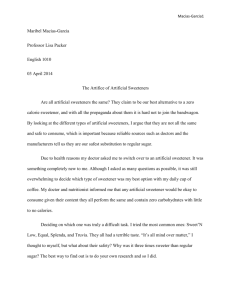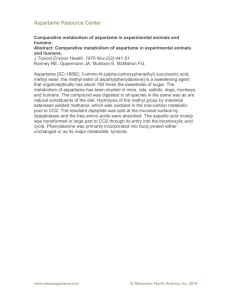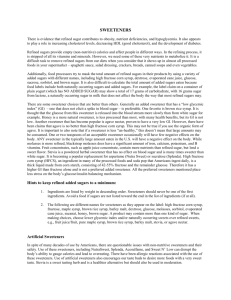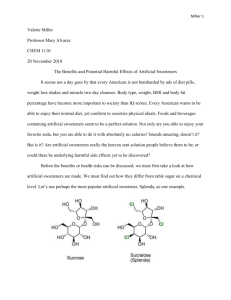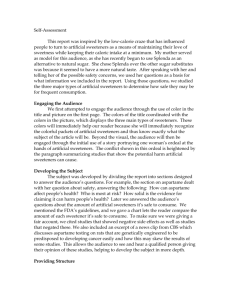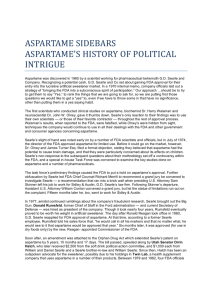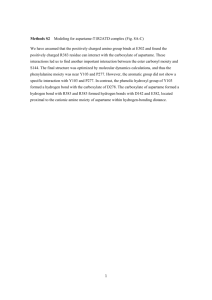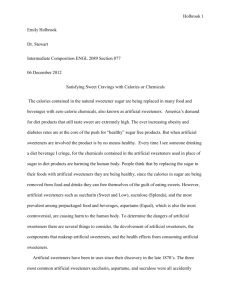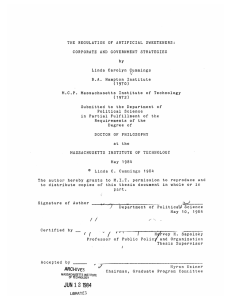Report
advertisement
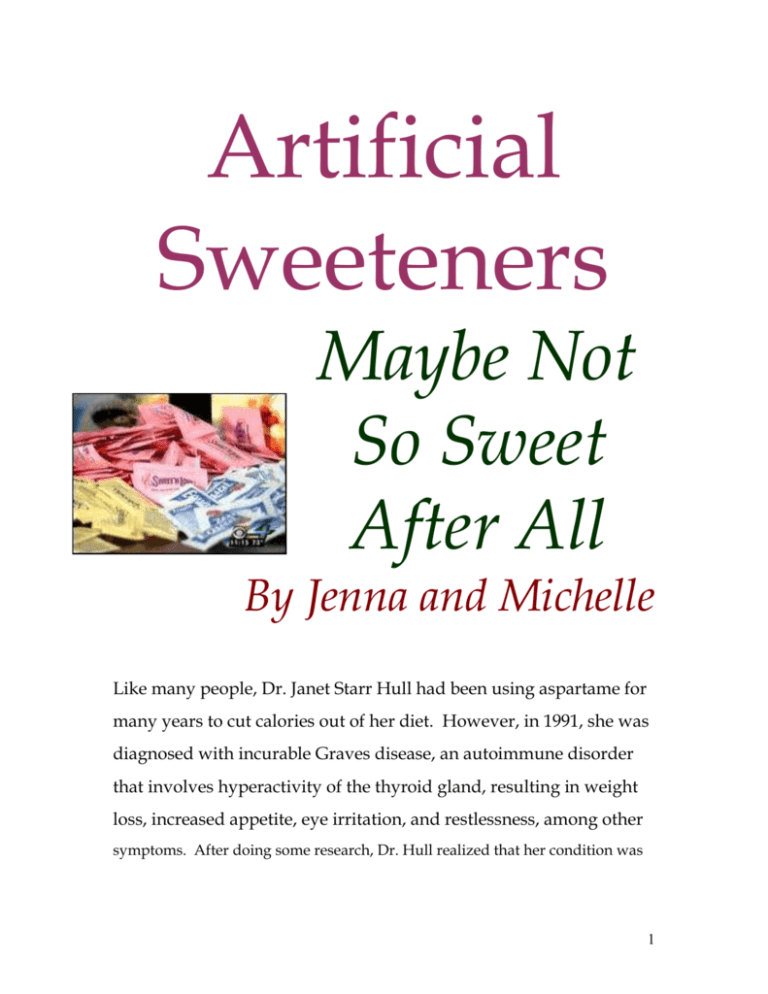
Artificial Sweeteners Maybe Not So Sweet After All By Jenna and Michelle Like many people, Dr. Janet Starr Hull had been using aspartame for many years to cut calories out of her diet. However, in 1991, she was diagnosed with incurable Graves disease, an autoimmune disorder that involves hyperactivity of the thyroid gland, resulting in weight loss, increased appetite, eye irritation, and restlessness, among other symptoms. After doing some research, Dr. Hull realized that her condition was 1 caused by aspartame poisoning (Total Health). She now dedicates much of her time educating others on what she sees as the dangers of using aspartame. This is only one of many instances in which artificial sweeteners may have caused serious disorders, even death. Aspartame is not the only target of these claims; saccharin and sucralose have both been targeted as well. Several studies have shown links between these sweeteners and cancer, liver inflammation, calcification of the kidneys, and many other side effects, both minor and serious. However, the companies manufacturing these sweeteners as well as the FDA continue to maintain that these products are safe. Numerous tests have been performed on each sweetener and no test has conclusively proven any unsafe consequences in humans using these products. The question, therefore, is whether to believe the government testing or the people who have suffered effects that they claim were from the sweeteners. If you are one of the millions of people who assume that these products are safe simply because they are on the market, hopefully this article will give you more information on which to base your decision of whether or not to use artificial sweeteners. Aspartame Although FDA approved and found in over 5000 products on the market, there has been much debate about the safety of aspartame, a no calorie sweetener sold under the commercial names of NutraSweet and Equal. The FDA denied approval for eight years, and when it did finally get approved, three out of five FDA scientists on special commissions advised against using aspartame (The Ecologist, Sept.). The additive was formally listed as a biochemical warfare agent by the Pentagon and the FDA scientists did not believe the test results adequately proved the safety of aspartame. Most consumers are not concerned with the safety of aspartame because the FDA approved the substance. 40 percent of the children population and 66 percent of the adult population consume aspartame on a regular basis (The 2 Ecologist, Sept.). Scientists however, have always been wary. Numerous independent studies have been performed producing many undesirable results, including headaches, memory loss, seizures, mood swings, Parkinson’s-like symptoms, tumors, and in rare cases, death (The Ecologist, Sept.). The most recent studies demonstrate a possible link between aspartame and leukemia and lymphoma. Other studies have shown that aspartame can have a negative effect on nerve cell development thus affecting the brain and overall development (The Ecologist, Feb.) Those who are especially at risk are young women planning to become pregnant. If they consume aspartame on a regular basis, they may be unintentionally poisoning their future child. Further, aspartame has recently been listed as a carcinogenic agent by The European Journal of Oncology (The Ecologist Dec.). Thus a high concentration of aspartame in expectant mothers may account for an increase in the number of infant leukemia and brain cancer cases. Women need to be informed in order to make an educated choice about consuming aspartame. While much of the evidence seems to point toward aspartame being unsafe, many scientists have provided a reason why these An ABC News clip about Aspartame testing on rats. Click to watch! tests yield negative outcomes in the rats being used in the tests. Many of these rats are specifically engineered so as to easily develop cancer, far more easily than any human would. Researchers do this so that they can more clearly see the results of their tests. However, there is much argument about the use of these rats because they are especially susceptible to cancer. The results of the tests do not have any bearing on what will happen to people who use the products. Therefore, it cannot be assumed that aspartame or any other sweetener tested on rats would give the same result in humans. 3 Saccharin Another artificial sweetener whose safety is in question is saccharin, which is sold under the commercial name Sweet‘N Low. Saccharin was first used in the late 1800s with no regulation by the FDA, but in 1977, they considered a ban on it because a study on rats resulted in the development of bladder cancer after being fed large doses of saccharin (FDA Consumer pg. 28). Since then, more studies have been conducted and many have come back with positive results, showing that saccharin is not harmful. The National Cancer Institute published many studies disproving the study that claimed saccharin causes bladder cancer and the National Toxicolgy Program decided that saccharin should no longer be listed as a cancer-causing agent (FDA Consumer pg. 28). It appears that saccharin may be a safer alternative to aspartame, but again, because the sweeteners are chemically composed, there is no way to tell how the body will react. The short term and long term effects of artificial sweeteners have not been completely researched or discovered. Sucralose In 1998, the FDA approved a new chemical called sucralose to be used as a sugar substitute, but since then, there have been many questions over whether or not the chemical is as safe as it is advertised. While sucralose, whose brand name is Splenda, is very similar to the sugar sucrose, it contains something that sugar does not: chlorine atoms. 4 Most people know of chlorocarbons as the compounds that have been released into the environment and resulted in the breakdown of the ozone layer. They are also present in pesticides. When attempting to create a new type of pesticide, sucralose was discovered. Many studies on chlorocarbons have provided irrefutable evidence that chlorine is toxic and a carcinogen within the human body, making many people skeptical of Splenda (womentowomen). However, the company maintains that the chlorines are chemically bound and will not be released at all during digestive processes. Unfortunately, no study yet has provided conclusive results as to whether this is true. There has been much speculation on the possible long term effects of using Splenda, but nothing has been serious enough to cause the FDA to change its stance on its safety. While there have been reports of side effects, including rashes, dizziness, diarrhea, headaches, and stomach pains, these are most likely caused by allergic reactions to the chemical sucralose (womentowomen). These reports have not been substantiated by the FDA, likely because the FDA does not put artificial sweeteners through “the same gauntlet of FDA safety trials as they do phamaceuticals”, so no one knows for certain if there really are any side effects or long-term effects of consuming Splenda or any other artificial sweetener (womentowomen). Some of their studies on rats have shown shrinkage of the thymus gland as well as swelling of the liver and kidneys, yet the FDA did not feel that these studies were conclusive because they were not based on human test animals (Total Health p. 32). The FDA was convinced that after reviewing more than 110 human and animal studies that sucralose was safe and approved it for use as a general-purpose sweetener (FDA Consumer p.28). How much is too much? Just as the FDA has guidelines on how much medicine it is safe to take over a period of time, they also have guidelines on how much of an artificial sweetener it is acceptable to consume. They cite what they term an "acceptable 5 daily intake" for each of the artificial additive, and they believe that the artificial sweeteners are safe when used in those specified amounts. The safe amount cited for Splenda and saccharin is just 5 mg/kg of body weight. For a 135 pound person, this comes out to just 0.3 grams of the product per day as suggested by the FDA as safe for consumption. Unfortunately, this is much less than what people normally do consume. One packet of Splenda or Sweet n’ Low contains 1 gram, and many consumers use far more than one packet per day. Aspartame, however, is safe in much greater amounts—50 mg/kg of body weight per day (Harvard Women's Health Watch p.2). This would allow 3 grams of aspartame to be safely consumed by a 135 pound person daily with presumably no ill effects. However, for saccharin and sucralose, what the FDA is claiming to be the safe amount of the sweetener to consume per day is very different than what people actually do consume. What are the effects of consuming more than what is considered safe? If long term effects of exceeding the safe limit of consumption exist, they are not yet known. Sweetener Chemical Name Acceptable Daily Intake Saccharin (Sweet 'N Low) 200-700 times sweeter than sugar benzosulfirride 5mg/kg of body weight per day Aspartame (Nutrisweet, Equal) 150-220 times sweeter than sugar amino acids and methyl alcohol 50 mg/kg of body weight per day Sucralose (Splenda) 600 times sweeter than sugar chlorinated sucrose (sugar) 5 mg/kg of body weight per day * Cited from the Harvard Women’s Health Watch 6 Are there any natural alternatives? Reports and test results about the possible harmful effects of aspartame as well as other artificial sweeteners are becoming more public, leading many consumers to look for more natural alternatives. Natural sugar has always been available to use as a sweetener, and while it is healthier than artificial sweeteners when used in appropriate portions, it is not calorie free. Consumers are mainly interested in another no-calorie sweetener to use as a replacement. There is another natural alternative to sugar—stevia. It is a non-caloric natural sweetener derived from the leaves of a South American shrub. However, it is not yet approved for use as a sweetener and can only be bought in health stores as a dietary supplement. As with the three other sweeteners discussed, the body does not recognize stevia and therefore does not digest it when it passes through the body (San Francisco Chronicle). For that reason, it, like artificial sweeteners, is calorie-free, but tastes much sweeter than natural sugar. How do they taste? Although artificial sweeteners are not naturally made, many consumers wonder if they taste natural. An internet poll by CBS news found that 58% of people preferred the taste of Splenda to any other artificial sweetener. This is compared to the 15% that prefer Equal and 10% who prefer Sweet and Low. The remaining 17% do not use artificial sweeteners. However, while Splenda may taste more natural than the other artificial sweeteners, the general consensus about the taste is that none of them taste natural. A study comparing the tastes of different diet colas showed that the diet colas had less overall flavor and a lingering artificial-sweetener flavor as compared to regular sodas (Battle of the Diet Cola Clones). The colas sweetened with aspartame (Diet Pepsi, Diet Coke, Coca-Cola Zero) had less of a lingering artificial sweetener than those sweetened with sucralose (Pepsi One, Diet Coke with Splenda) according to the article “Battle of the Diet Cola Clones.” Although everyone has their own opinion and 7 taste preferences, the opinion that artificial sweeteners do not taste natural is almost unanimous. With all of the controversy over the safety of these artificial sweeteners, it is hard to know what to do. The easiest option is to trust the FDA, the primary judge of the safety of any product on the market. Although many tests have been performed showing deleterious results, the FDA would be quick to ban any product that conclusively is shown to be harmful just as they did with saccharin in the seventies. Therefore, the main conclusion that can be drawn from all of these studies is that as long as these products are used in minimal amounts, such as those recommended by the FDA, there is little chance of suffering any negative consequence. 8 Resources “Artificial Sweeteners: Are they Safe?” ABC News, Good Morning America. February 16, 2006. “Artificial Sweeteners: No Calories…Sweet!”, FDA Consumer. July-August 2006. Pg. 27. “Artificial sweeteners: Okay in moderation.” Harvard Women’s Health Watch. July 2004. Pg. 2-3. “Battle of the Diet Cola Clones.” www.ConsumerReports.org. December 2005. Pg. 9. “The Dangers of Artificial Sweeteners.” Total Health, Vol. 27, No.1. “Dumb Food.” The Ecologist. February 2006. Pg. 11. “Life After Aspartame.” The Ecologist. September 2005. Pg. 50-51. “Splenda 101.” San Francisco Chronicle. September 15, 2004. “Sugar substitutes and the potential danger of Splenda.” www.womentowomen.com/nutritionandweightloss/splenda.asp. “Sweet and Deadly.” The Ecologist. December 2005. Pg. 6. “The Truth about Sweeteners.” CBS Broadcasting, Inc. http://cbs4.com/topstories/local_story_122000147.html . May 1, 2006. 9
